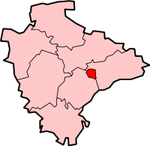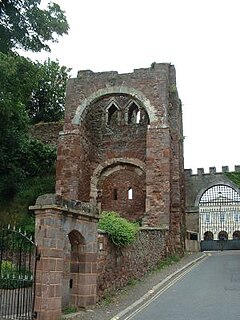Exeter
A number of other places have taken their names from Exeter
| City of Exeter | |
|---|---|
 Shown within Devon | |
| Geography | |
| Status: | City |
| Region: | South West England |
| Admin. County: | Devon |
| Area: - Total |
Ranked 303rd 47.03 km² |
| Admin. HQ: | Exeter |
| ONS code: | 18UC |
| Demographics | |
| Population: - Total (2002 est.) - Density |
Ranked 182nd 111,110 2,363 / km² |
| Ethnicity: | 97.6% White |
| Politics | |
| Arms of Exeter City Council Exeter City Council http://www.exeter.gov.uk | |
| Leadership: | Leader & Cabinet |
| Executive: | |
| MP: | Ben Bradshaw |
The city of Exeter is the county town of Devon, in England, UK. It is located at 50° 43' 25" N, 3° 31' 39" W. In the 2001 census its population was recorded at 111,067. The city's motto, Semper fidelis, was suggested by Elizabeth I.
Situation
Until the construction of main road by-passes in the twentieth century, Exeter was the lowest bridging point of the River Exe, and therefore developed as an administrative and route centre. From Saxon times until the nineteenth century, the diocese of Exeter covered the whole of the counties of Devon and Cornwall, and civil administration and services tended to follow the lines of the ecclesiastical. Exeter was also a port: the limit of tides of the River Exe lies below Exeter, and the small town of Topsham on the estuary (nowadays within the city limits) developed as a port for the city, but goods were transported to the city's quays in lighters. Eventually a ship canal was constructed so that ocean-going vessels could reach the city's quays, and this remained in regular use until ships increased in size with the development of steam power. It is still used for leisure boating.
Business
The city provides light industries and services to a sizeable area. The Met Office, the main weather forecasting organisation for the United Kingdom and one of the most significant in the world, has recently relocated from the London area to Exeter. It will be one of the three largest employers in the area (the others being the University of Exeter and Devon County Council, and it will provide a welcome boost to the local economy.
History
There was a settlement on the banks of the Exe prior to the Romans' foundation of Isca Dumnoniorum in c. AD 50, building a defensive wall to surround the settlement. Isca was the most south-westerly Roman fortified settlement in England. Significant parts of the Roman wall remain (obviously much patched in subsequent centuries), and most of its route can be traced on foot. There is a substantial Roman baths complex, though because this is close to the cathedral, it has not yet been practicable to excavate it for public view. Exeter was also the southern starting point for the Fosse Way Roman road.
In 876 Exeter was attacked by the Danes.
In 1068 the city was attacked by William the Conqueror, submitting only after a 18 day siege.
The city took the Royalist side in the English Civil War.
Industrial Revolution
Early in the English Industrial revolution, Exeter's industry developed on the basis of locally available agricultural products, since the city's location on a fast-flowing river gave it ready access to water power. However when steam power replaced water in the later nineteenth century, Exeter was too far from sources of coal (or iron) to develop further. As a result the city declined in relative importance, and was spared the rapid nineteenth century development that changed many historic European cities out of all recognition; this may be why it is nowadays regularly voted within the top few cities of the United Kingdom for quality of life.
World War II
Exeter was extensively bombed by the Germans during WWII, in a 1942 raid that formed part of the Baedeker Blitz. Forty acres of the city were levelled by incendiary bombing by the German Luftwaffe: many historic buildings were destroyed, and others including Exeter Cathedral were damaged. The city was rebuilt in the 1950s in an attempt to preserve its ancient heritage, though many authorities feel that the post-war reconstruction was weak and failed to conserve partly-damaged structures that could have been saved, as well as making too many concessions to motor traffic. Previously regarded as second only to Bath as an architectural site in southern England, Exeter is now a city with some beautiful buildings rather than a beautiful city. As a result, although there is a significant tourist trade, Exeter is not dominated by tourism.
Politics and administration
Exeter forms a single parliamentary seat. It is relatively marginal, and since the second World War its Member of Parliament has usually been drawn from the governing party. At the UK general election, 1997, Ben Bradshaw was elected as MP for Exeter.
Exeter's city council is a local government district authority, and shares responsibility for local government with the Devon County Council. In recent years, the city council has been dominated by Labour Party and Liberal Democrat members. Since 2003, no party has had a majority on the council.
Notable Buildings

The front of Exeter Cathedral

Ruined gatehouse at Rougemont Castle. Note the red sandstone, characteristic of many older Exeter buildings.
Among the notable buildings in Exeter are:
- The cathedral, founded in 1050 when the bishop's seat was moved from the nearby town of Crediton (birthplace of Saint Boniface) because Exeter's Roman walls offered better protection against "pirates", presumably Vikings. A statue of Richard Hooker, the sixteenth century Anglican theologian, who was born in Exeter, has a prominent place in the Cathedral Close.
- The ruins of Rougemont Castle, built soon after the Norman Conquest; later parts of the castle are still in use as an Assize court, though a new courts complex is under construction and the castle will probably become accessible to tourists as a result.
- The Guildhall, the oldest municipal building in England still in use.
- The Custom House in the attractive Quay area
- St Nicholas Priory in Mint Lane.
- A number of medieval churches including St Mary Steps which has an elaborate clock.
Many of these are built in the local dark red sandstone, which gives its name to the castle and the park that now surrounds it (Rougemont = red hill).
Culture
Literature
- The original manuscript of one of the most important documents in Anglo-Saxon literature, the tenth century Exeter Book, is kept in the cathedral vaults. The Exeter Book is one of four manuscripts that between them contain virtually all the surviving poetry in Old English. It includes most of the more highly regarded shorter poems, some religious pieces, and a series of riddles, a handful of which are famously slightly lewd.
- The Inquisitio Eliensis, the "Exon Domesday" (so called from the preservation of the volume at Exeter), is a volume of Domesday Book that contains the full details which the original returns supplied.
Theatre
- The Northcott Theatre is located on the campus of the university. It is one of relatively few provincial English theatres to maintain its own repertory company. Its annual open air Shakespeare performance in the grounds of Rougemont Castle is well regarded nationally.
- There are also two amateur theatre buildings with associated companies
Music
- Exeter does not have a resident professional orchestra. The Bournemouth Symphony Orchestra tours to the city regularly.
- The cathedral choir is nationally known, and the cathedral is frequently the venue for concerts by visiting orchestras.
- There is an annual Festival, of all the arts but with a particular concentration of musical events
Museums and galleries
- The city museum is the Royal Albert Memorial Museum in Queen Street.
- The Phoenix Arts Centre occupies the former university site in Gandy Street.
- Spacex is a long established modern art gallery
Newspapers
- Express and Echo, daily
- Flying Post, weekly
Twin towns
Exeter is twinned with:
The city also seeks to maintain a relationship with HMS Exeter.
Colleges and Universities
- The University of Exeter has two campuses in the city, both notable for their attractive parkland. It is one of the largest employers in the city.
- Exeter is one of the four main sites of the University of Plymouth
- The Peninsula Medical School, a joint operation of the two universities, has one of its main sites in Exeter
- St Loye's School of Health Studies, well known for training in occupational therapy has now been incorporated into the University of Plymouth.
- Exeter College is a major Further Education college
- Exeter is home to several substantial language schools
Sports
- Exeter's football club, Exeter City F.C., was relegated from the Football League in 2003 after 83 years' membership.
- Rugby Union is popular in the south-west: Exeter's team is the Exeter Chiefs.
- The University of Exeter has a strong reputation in sport and regularly wins or comes close to winning national trophies in inter-university sports
Transport
The city remains at a critical point on the transport networks.
Road
- the M5 motorway from Bristol and Birmingham terminates at Exeter, continuing to Plymouth and South Cornwall as the A38.
- the older A30 road provides a shorter but sometimes slower route to London, and continues west to Okehampton and Cornwall
Rail
- The main railway station is Exeter St David's
- there are two railway lines to London, a faster route via Taunton to Paddington and a slower one via Salisbury to Waterloo
- other main lines go via Bristol, Birmingham, the Midlands and north of England to Scotland, and southwards to Torbay and to Plymouth and then on into Cornwall
- branch lines run to Exmouth and Barnstaple; there is a summer weekend service to Okehampton for access to Dartmoor.
Air
There is a small airport (IATA code EXT), and the local airline, previously called Jersey European and British European but now known as Flybe, is a significant local employer. There are scheduled services to Toronto (seasonal), to a few cities in the U.K. and to the Channel Islands and Isles of Scilly, and more numerous charter flights (also seasonal) to holiday destinations such as the Canary Islands and the Balearics.
See also
External links
- Information site linked to the local newspaper
- Exeter Web Directory - a comprehensive directory of Exeter related websites and services.